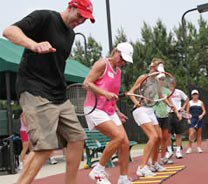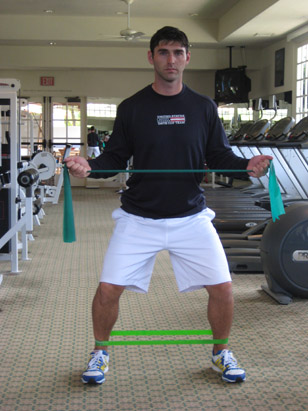In fact, the few that use tennis workout programs are usually tournament level tennis players looking to play college and pro tennis. Still, even club tennis players can learn a thing or two from a tennis workout program of the pros.
Perhaps no other sport can match tennis for the breadth of fitness required to play at a high level.
Forget those two older guys with pot bellies that tap it around on your club court. If you want to hang with the best in the sport and win age-group or appropriate-level tournaments, you’re going to have to get into fantastic shape to not only endure, but have plenty left in long, closely contested matches.
Not just any tennis workout program will do.
What is a Tennis Workout Program, And Why?


Tennis calls on many aspects of fitness in the course of a match, from strength to speed, from agility to flexibility, and add endurance on top of all that. Tennis players are strong, they are fast, they are quick, they are agile, they are flexible and they can play all day.
The next time that you watch a professional match, notice how many times players nearly do the splits, how many times they dart back and forth across the court during a long rally, how fresh they look even after three hours, summoning more strength then than many athletes can muster even in the opening minutes.
Better yet, take a look at a slow-motion video of a player hitting a powerful forehand—you will see muscles rippling like you never have before. Tennis players have it all yet cannot concentrate too much on any one aspect of fitness. That makes finding a sound tennis workout program a challenge.
Key Focus of Every Tennis Workout Program


Tennis players do not want to get too buff and tighten all of the muscles that they use in a match. They also do not want to focus solely on endurance because they have many short, explosive movements to make in the context of a match.
They also don’t want to simply build up their fast-twitch muscles because they must perform at a high level for several hours. This unique mix makes the compilation of an ideal tennis workout program difficult to prescribe, but here are a few hints in that quest:
Any tennis workout program that is worth the paper it’s printed on must include exercises done both on the court and in the gym. A little work on the track would be great, too.
Core Muscles and Exercises That Must Be Covered in a Tennis Workout Program
To produce the strength needed to hit shots with both pace and spin, the legs, core, arms, back and shoulders must be worked. Those body parts will also come into play as dozens of short sprints are run in the playing of a match and lightning-fast changes of direction are required time after time. Standard leg exercises include the leg press and squats in the gym.
Standard arm exercises include the bicep and tricep curls, as well as the bench and shoulder presses. The core is really the key to strong ground strokes and the serve, so be sure to spend most of your time getting that part of the body fit. To work the core and shoulders, use a medicine ball, as many top tennis players do.
Toss it back and forth with a partner either in the gym or across the net. To amplify the exercise’s effects, make an exaggerated movement to either side as you catch and throw the ball. You should also throw it overhand to get your shoulders buzzing. Your back will also benefit from flinging the ball around.
Speed and Agility Exercises in a Tennis Workout Program


To increase your speed and agility, do any variety of shuttle runs on the court and incorporate a few footwork exercises as well.
Here are the details on one great shuttle run: place four tennis balls on the court, two at the “T”, one at the net, one halfway between, all in a line.
Starting at the baseline, sprint to each ball and pick them up, one at a time, placing them on the baseline. Touch the baseline each time and when the last ball makes it there, begin to return the balls one at a time to their original spots.
Continue until all balls are in their starting positions. This is a standard shuttle run that tennis players have done for many, many years.
A good footwork drill proceeds as follows: place two cones two feet apart, then run a figure eight around the cones without knocking them over. Continue this for one minute. Another good cone drill is placing three in a triangle and running around each one in order as you hit phantom forehands and backhands. This drill has been used by Roger Federer, among others.
Tennis Workout Program – Endurance Exercises
To build up your endurance for that long match that you must win at all costs, practice interval running, preferably on a track. This will most closely simulate the type of running that you do in tennis, when long rallies are interspersed with short sprints (unless you are playing a human backboard on clay, which does happen occasionally).
Incline Exercises to Build Tennis Strength in the Lower Body


On a track, sprint on the straight-aways and jog on the curves (walk if you must, but alternate speeds depending on where you are on the track). If you are not able to use a track, get on a treadmill and adjust it to a slight incline. Sprint uphill for 100 meters, then walk down 100 meters and repeat.
If you aren’t near a treadmill, find a good hill to do this same exercise. Such interval running will boost your heart rate recovery between long points in the course of a game.
For greater flexibility, stretch all of your major muscle groups before working out. Some players even use yoga to improve their flexibility and balance. Added flexibility will help to prevent injuries and also increase your defensive capabilities, as well as the power on your strokes. If you do choose to do yoga, practice it at least once a week.
Structuring Your Tennis Workout Program – Key Guidelines


It will be impossible to do all of these types of workouts in the course of one day. You would have to quit your day job to work it in! That’s part of the point. Your body will need rest as you tax it in a variety of ways with this tennis workout program. Thus, be sure to alternate your training, spacing out leg presses, for instance, with at least a day’s rest in between.
When you are not working on strength one day, do some interval running. The next day, you can do yoga and a few shuttle runs, then back to strength training. Be sure also to give your body a day or two off from all exercise.
Here is a proposal for how to structure your tennis workout program:
Monday—Strength workouts for arms, legs, shoulder, core
Tuesday—Shuttle runs and play
Wednesday—Strength workouts
Thursday—Interval running
Friday—Yoga
Saturday—Light strength training and play
Sunday—Off
Cool Down & Maintenance in Your Tennis Workout Program
As you vary your tennis workout program, you will find that no one part of your body becomes overly tired and sore. If you overdo it early in your tennis workout program, be sure to ice any soreness and talk to a doctor if certain pains persist. A lot of problems can be avoided if you don’t try to become super-fit in the course of two days or even two weeks. Start off many exercises with one set the first time, no matter how short the workout feels. Then, increase the number of sets in successive weeks as your body gets used to being stretched and pulled in new ways.
All of the fitness training in the world might not make you a better player if your strokes are weak, but if you are already a solid player, excellent fitness can be the thin difference between winning and losing. The fit player is confident even in the third or fifth set, knowing that he has put in the hard work necessary to outlast anyone across the net. A good tennis workout program will be interesting enough and varied enough to keep you at it for the long haul.
Learn to Hit a Forehand Like Roger Federer
If you want to jumpstart your forehand and play like the PROS, check out my 70+ page Tennis Ebook that will immediately show you how you can take your forehand to the next level.
The Modern Forehand Domination Ebook is guaranteed to improve your tennis technique, and increase power, topspin and accuracy of your tennis forehand!
Modern Tennis Forehand Ebook
Learn How to Hit a Forehand Like Federer, Nadal and Djokovic

